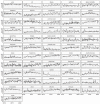Seasonal Patterns and Trends in Dermatoses in Poland
- PMID: 35897306
- PMCID: PMC9330858
- DOI: 10.3390/ijerph19158934
Seasonal Patterns and Trends in Dermatoses in Poland
Abstract
Background: The amount of data available online is constantly increasing, including search behavior and tracking trends in domains such as Google. Analyzing the data helps to predict patient needs and epidemiological events more accurately. Our study aimed to identify dermatology-related terms that occur seasonally and any search anomalies during the SARS-CoV-2 pandemic.
Methods: The data were gathered using Google Trends, with 69 entries between January-2010 and December-2020 analyzed. We conducted the Seasonal Mann-Kendal Test to determine the strength of trends. The month with the highest seasonal component (RSV) and the lowest seasonal component (RSV) was indicated for every keyword. Groups of keywords occurring together regularly at specific periods of the year were shown.
Results: We found that some topics were seasonally searched in winter (e.g., herpes, scabies, candida) and others in summer (e.g., erythema, warts, urticaria).
Conclusions: Interestingly, downward trends in searches on sexually transmitted diseases in comparison with increased infection rates reported officially show a strong need for improved sexual education in Poland. There were no significant differences in trends for coronavirus-related cutaneous symptoms during 2020. We have shown that the seasonality of dermatologically related terms searched in Poland via Google did not differ significantly during SARS-CoV-2 pandemic.
Keywords: Google Trends; STD; dermatoses; infodemiology; seasonality; trends.
Conflict of interest statement
The authors declare no conflict of interest.
Figures


Similar articles
-
Seasonal trends in hypertension in Poland: evidence from Google search engine query data.Kardiol Pol. 2018;76(3):637-641. doi: 10.5603/KP.a2017.0264. Epub 2018 Jan 3. Kardiol Pol. 2018. PMID: 29297185
-
United States Influenza Search Patterns Since the Emergence of COVID-19: Infodemiology Study.JMIR Public Health Surveill. 2022 Mar 3;8(3):e32364. doi: 10.2196/32364. JMIR Public Health Surveill. 2022. PMID: 34878996 Free PMC article.
-
Infodemiology of cluster headache seasonality: A proof of concept by a Google Trends analysis.Headache. 2023 Jan;63(1):89-93. doi: 10.1111/head.14444. Epub 2023 Jan 18. Headache. 2023. PMID: 36651518
-
Google Trends in Dermatology: Scoping Review of the Literature.JMIR Dermatol. 2021 May 25;4(1):e27712. doi: 10.2196/27712. JMIR Dermatol. 2021. PMID: 37632813 Free PMC article.
-
More than just a stye: identifying seasonal patterns using google trends, and a review of infodemiological literature in ophthalmology.Orbit. 2023 Apr;42(2):130-137. doi: 10.1080/01676830.2022.2040542. Epub 2022 Mar 3. Orbit. 2023. PMID: 35240907 Review.
Cited by
-
Did the COVID-19 pandemic impact urticaria information-seeking behavior in China? A retrospective longitudinal study.Front Public Health. 2023 Jan 19;11:1098066. doi: 10.3389/fpubh.2023.1098066. eCollection 2023. Front Public Health. 2023. PMID: 36741961 Free PMC article.
-
Closing the AI generalisation gap by adjusting for dermatology condition distribution differences across clinical settings.EBioMedicine. 2025 Jun;116:105766. doi: 10.1016/j.ebiom.2025.105766. Epub 2025 Jun 2. EBioMedicine. 2025. PMID: 40460693 Free PMC article.
References
-
- Morga J. Dermatolodzy: 5 Mln Osób z Chorobami Skóry Spychanych w Polsce Na Margines|Nauka w Polsce. [(accessed on 23 August 2021)]. Available online: Naukawpolsce.pap.pl.
-
- Śpiewak R. Częstość Występowania Chorób Skóry w Losowej Grupie Dorosłych Polaków. Estetologia Med. Kosmetol. 2012;2:50–53. doi: 10.14320/EMK.2012.010. - DOI
-
- Fox S. E-Patients with a Disability or Chronic Disease. Pew Internet and American Life Project; Washington, DC, USA: 2007.
MeSH terms
LinkOut - more resources
Full Text Sources
Medical
Research Materials
Miscellaneous

